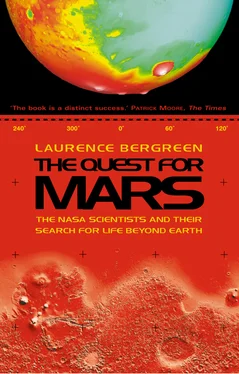1 ...8 9 10 12 13 14 ...25 He met his wife Cindy by accident in 1990 when she was working at NASA for a contractor. It seems there was another J.B. Garvin with whom she was doing business, and Jim kept getting e-mails intended for the other one. So he got in touch with her to clear up the confusion. He found himself talking on the phone with her, and she coaxed him gently into asking her on a date. “I often get too focused on my work. I wished I didn’t, but that’s the way it is,” he confides. Cindy was determined to change all that.
When they came face to face, Cindy already knew what he looked like; to this day, Jim is not sure how she knew. They went to a hockey game, and not long after that, moved in together. Cindy recognized that his interests were a little unusual. Here’s a Phi Beta Kappa from Brown, a Ph.D., who says his most valuable possession in the world is a complete set of Jim Bunning baseball cards. He owns practically every Bunning card ever issued, tracing his pitching career from 1954 through the 1980s. Cindy liked shopping, dining out, and other normal activities. That was fine with Jim, he wanted to be with someone normal, someone who would keep him in touch with daily life. They married in 1992. We sit drinking and talking until the sky begins to brighten almost to daytime intensity, and we return to base a little after two in the morning.
The next day, while packing to leave, Jim ponders what to do with the data he’s collected during the week in Iceland. He must get it out – in the new NASA, nothing is secret – so he will post it on various Internet sites, for starters. He will write multiple papers, some of which will appear in scientific journals. He will give lectures. He will share the information with Icelandic scientists. “It’s my job as a research scientist at NASA to publish the results in Science , Nature , and other journals. That’s my job, to disseminate.” He will have plenty to discuss, for a crowded schedule of Mars exploration lies ahead. “We’re launching again in December and sending a small probe to the south polar ice cap on Mars, which we think is all frozen carbon dioxide. It’s so cold, one hundred to two hundred and fifty degrees centigrade below zero. We’re also asking other, very fundamental questions: Did life start on Mars? If it did, is it dormant, frozen, fossilized? Is it still there? Is it all microbial? What can it tell us about extremophile life on Earth?” Jim asks, savoring each question.
“I think the potential for Mars is totally untapped, and that’s something of a surprise,” he continues. “When we first got there in the sixties with the Mariner spacecraft, we thought, ‘Oh, my God, there are going to be Martians, canals, it’s going to be great.’ But when we got there, it looked like the moon. Mars puzzled us. We returned with Viking in the mid-seventies, looking for life, and instead we found the great arctic desert of Mars. We saw frost form in the winter, and we saw snow. We saw rocks and pits that reminded us of gas bubbles in the volcanic rocks you see here in Iceland, but we didn’t see the obvious signatures of life. We’ve got to go back. We’ve got to understand this place. We’ll have a series of robotic voyages to set the stage for bringing back samples of Mars to Earth to investigate the chemistry and – maybe – signs of life. And then someday we’ll put human beings there, God and the great American economy willing.”
The taxi cab heading home from JFK Airport feels as cramped as Oscar’s co-pilot seat. I’m probably in more danger barreling along the Grand Central Parkway than I was aloft in Oscar’s little Aerospatiale. Night falls for the first time in a week; how strange the darkness seems. After experiencing Iceland’s white nights and thinking intensely about what it’s like to walk across the surface of Mars, I find that nothing on Earth looks quite the same. The initiation is over, and back home, I reflect on a whimsical passage from Ray Bradbury’s sci-fi novel, The Martian Chronicles , published in 1950:
The ship came down from space. It came from the stars and the black velocities, and the shining movements, and the silent gulfs of space. It was a new ship; it had fire in its body and men in its metal cells, and it moved with a clean silence, fiery and warm. In it were seventeen men, including a captain … Now it was decelerating with metal efficiency in the upper Martian atmospheres. It was still a thing of beauty and strength. It had moved in the midnight waters of space like a pale sea leviathan; it had passed the ancient moon and thrown itself onward into one nothingness following another. The men within had been battered, thrown about, sickened, made well again, each in his turn. One man had died, but now the remaining sixteen, with their eyes clear in their heads and their faces pressed to the thick glass ports, watched Mars swing up under them.
“Mars!” cried Navigator Lustig.
“Good old Mars!” said Samuel Hinkston, archeologist.
According to Bradbury, this landing, the third human expedition to Mars, was supposed to occur in April 2000. NASA is running a little behind schedule, but sends spacecraft to Mars as often as budgets and planetary orbits allow. For now, they are robotic missions; in time, they will bring people to the Red Planet.
Welcome to the new Martian chronicles.
Jim Garvin’s collection of Jim Bunning baseball cards got me to thinking about what is perhaps the most famous baseball card of all – the 1909 portrait of Honus Wagner in a Pittsburgh Pirates uniform. When I gaze at the face of this young man, who seems to be staring into space, I find myself asking, “What was it like to be alive in 1909?” I have little idea, although it was just the other day, in geological terms. All I have to go on are artifacts, such as this famous baseball card. I can’t watch Wagner play baseball, and I can’t hear his voice; all I can see is a fuzzy image of the athlete in a uniform, a trick of light and shadow, an impression of life as it once was. To fill in the gaps, I would have to look beyond the card, but if I’m relying on the card, and only the card, I have precious little data.
The card, and its limitations, call to mind the tantalizing images of fossilized bacteria in a 3.9 billion year-old meteorite from Mars – images that may be the first scientific evidence of life beyond Earth. Fossilization occurs when minerals replace organic elements in once living things. The morphology remains, although the chemistry is different. Still, scientists can learn a lot from fossils. They can detect the approximate age, which is crucial, and, by studying fossils in their natural setting – in situ – they can extrapolate a great deal about the geological, chemical, and biological circumstances surrounding them. “Fossils are the autographs of time,” wrote the American astronomer Maria Mitchell. For these reasons, fossilized bacteria from Mars – if that’s what they are – have great appeal; they are our best indication of life beyond Earth. Like the antique baseball card, they offer only a very narrow glimpse into the past. 1909, the year of the Honus Wagner card, wasn’t very long ago, but it’s long enough past to seem quite mysterious. How much more difficult it is, then, to construct a scenario for the existence of life on Mars several billion years ago from the evidence contained in a meteorite.
If the fossilized bacteria are genuine artifacts of Martian life, they raise more questions than they answer. If life started on Mars, how did it begin? Is it still there? If not, when did it end, and why? If it’s on Mars, where else in the universe might it be, and what form does it take? Did it originate on Mars, on Earth, or somewhere else? All these Genesis Questions point up how much scientists have yet to learn about how life began. In the course of asking questions of various scientists who study these problems for a living, almost every reply I received began this way: “No one knows, but …” That’s followed closely by, “There are several possible scenarios,” and “Well, current speculation has it that …” The answers are all variations on the theme that no one knows, yet. But scientists have hypotheses. They have scenarios. The meteorite from Mars has inspired a widely accepted scenario – I’ll call it the Best Guess Scenario – concerning the origins of life on the Red Planet, and how it came to be transported to Earth.
Читать дальше












